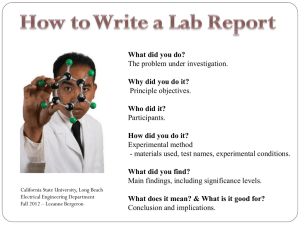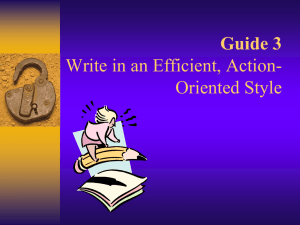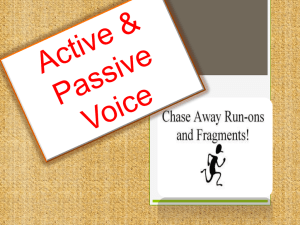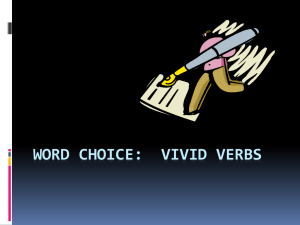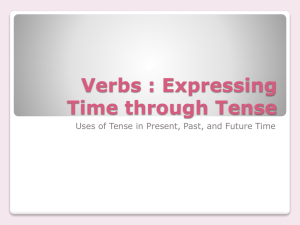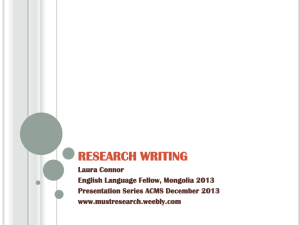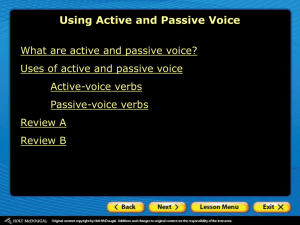"To Be" Verbs and Passive Voice
advertisement
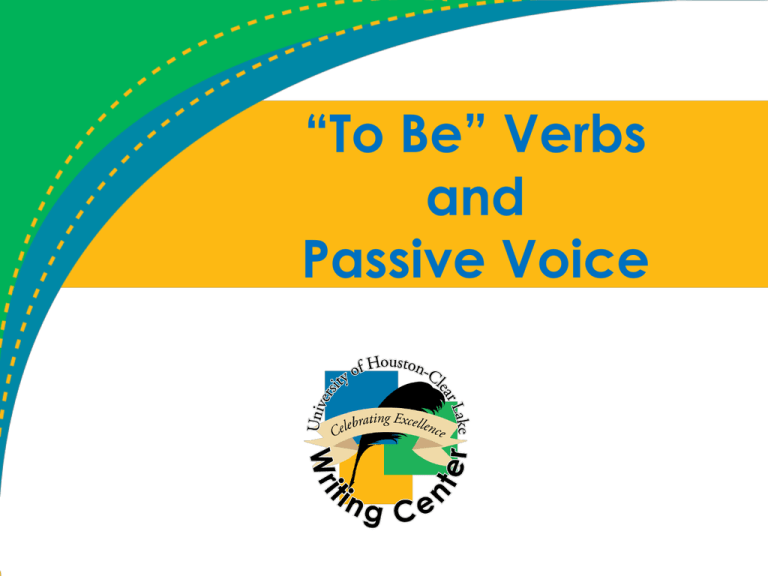
“To Be” Verbs and Passive Voice What is a “to be” verb? • A verb that is used in a number of ways in the English language, including linking, passive construction, and auxiliary • Has many forms, including is, am, are, was, were, be, being, and been How are they used? • Present Tense: – I am/we are – You are – He, she, it is/they are • Past Tense: – I was/we were – You were – He, she, it was/they were • Perfect form: – I, you, they, we have been • Progressive form: – I am being, they are being, etc. Linking Verbs • “To be” verbs are used as linking verbs to describe the role or description of the subject. They are called this because they link the subject and the subject complement. – Examples: The cat is black. – They are late to the party. – He was not very happy. – Driving a car is faster than walking. Now you try! • Create a sentence that describes something with a linking verb. Auxiliary verbs • Used with progressive and progressive perfect tenses Present progressive: The dog is barking. Past progressive: The dog was barking. Future progressive: The dog will be barking. Present perfect progressive: The dog has been barking for five minutes. – Past perfect progressive: The dog had been barking when I got home. – Future perfect progressive: The dog will have been barking for 20 minutes by the time I finish this workshop! – – – – For more information… • See the PowerPoint on Verb Tenses on the Writing Center website. Now you try! • Create a sentence with a progressive tense and an auxiliary verb. Passive Voice • Passive voice occurs with the emphasis is placed on the object of the action rather than the subject. – Example: • Active voice: The boy threw the ball. • Passive voice: The ball was thrown. Why use passive voice? • • • • • • The actor is unknown: – The cave paintings of Lascaux were made in the Upper Old Stone Age. [We don't know who made them.] The actor is irrelevant: – An experimental solar power plant will be built in the Australian desert. [We are not interested in who is building it.] You want to be vague about who is responsible: – Mistakes were made. [Common in bureaucratic writing!] You are talking about a general truth: – Rules are made to be broken. [By whomever, whenever.] You want to emphasize the person or thing acted on. For example, it may be your main topic: – Insulin was first discovered in 1921 by researchers at the University of Toronto. It is still the only treatment available for diabetes. You are writing in a scientific genre that traditionally relies on passive voice. Passive voice is often preferred in lab reports and scientific research papers, most notably in the Materials and Methods section: – The sodium hydroxide was dissolved in water. This solution was then titrated with hydrochloric acid. (Corson, Tim and Rebecca Smollett) “To Be” verbs used with passive voice • When using to be verbs with passive voice, they are used similarly to linking and auxiliary verbs. • Passive sentences are constructed as follows: – [thing receiving action] + [to be verb] + [past participle of verb]+[by] + [thing doing action] (“Active/Passive Verb Forms”). Examples • Present progressive tense: “The sweater is being knit by the girl.” • Simple past: “The sweater was knit by the girl.” • Simple past, plural: “The pies were made by different people.” Now you try! • Create a sentence in the passive voice. Works Cited Corson, Tim and Rebecca Smollett. “Passive Voice: When To Use It and When To Avoid It." University College Writing Centre. University of Toronto, n.d. Web. 12 Nov, 2014. “Active/Passive Verb Forms.” Englishpage.com. Language Dynamics, n.d. Web. 12 Nov, 2014.
